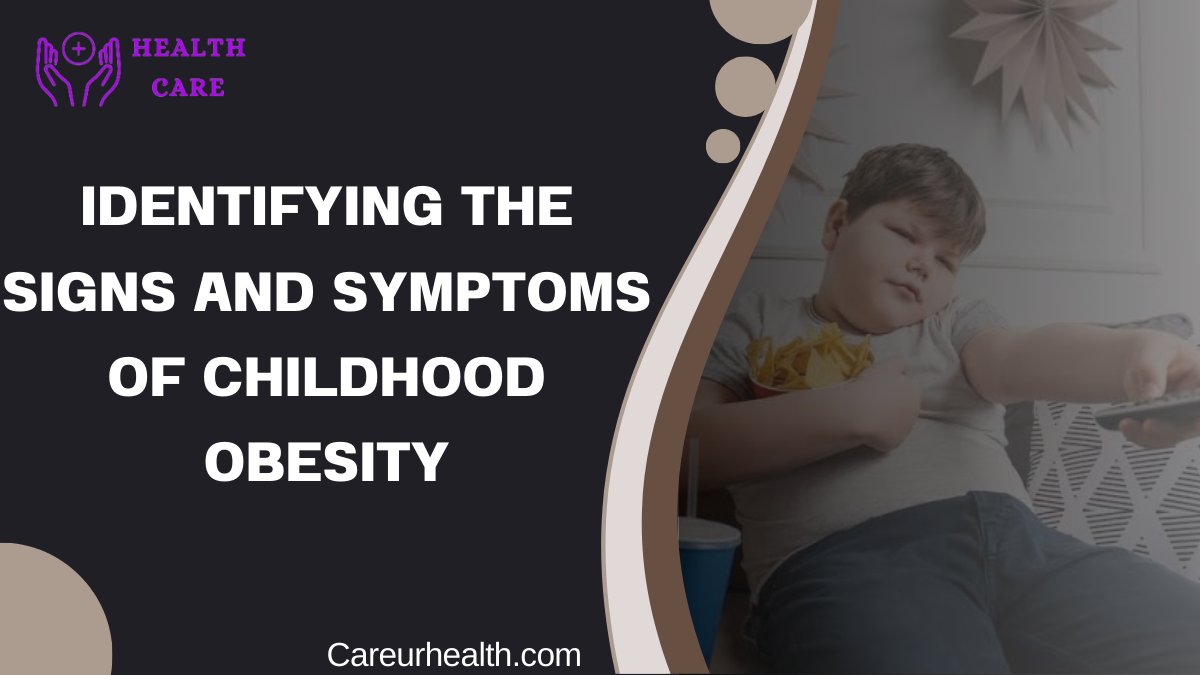Introduction: Recognizing the Signs and Symptoms of Childhood Obesity
The early signs and symptoms of childhood obesity include rapid weight gain. Childhood obesity has become a significant health concern globally, with increasing numbers of children affected by excessive weight gain at an early age.
Understanding the signs and symptoms of childhood obesity is crucial for early intervention and prevention.
Parents, educators, and healthcare providers play an essential role in identifying these signs and taking steps to address them.
Key Takeaways: Understanding Childhood Obesity
- Early identification of obesity can prevent long-term health issues.
- Behavioral changes in children can be indicators of obesity.
- Physical symptoms often accompany childhood obesity.
- Emotional well-being is deeply connected to obesity in children.
- Intervention strategies are critical for managing and reducing obesity.
Sleep Disturbances and Health Implications
Sleep disturbances are another symptom that may be associated with childhood obesity.
Obese children are more likely to suffer from sleep apnea, a condition where breathing stops and starts repeatedly during sleep. The early signs and symptoms of childhood obesity include rapid weight gain.
This can result in poor-quality sleep, leading to daytime fatigue and a lack of energy. In turn, the child may be less likely to engage in physical activities, contributing further to weight gain.
Mental Health and Social Consequences
A child’s mental and emotional health can also provide clues to the presence of obesity. Obese children may experience lower self-esteem, depression, or anxiety due to their body image and societal pressures.
They may withdraw from social interactions or be subjected to bullying, which can further impact their mental health and exacerbate unhealthy eating habits. The early signs and symptoms of childhood obesity include rapid weight gain.
Physical Symptoms and Health Complications
As childhood obesity progresses, more pronounced physical symptoms and health complications can develop.
One common physical sign is the development of stretch marks on the skin, particularly around the abdomen, hips, and thighs.
These marks are caused by rapid weight gain and are often accompanied by areas of skin discoloration known as acanthosis nigricans. Which typically appear in the folds of the skin, such as the neck and armpits.
Joint Pain and Breathing Difficulties
Joint pain and discomfort can also be symptoms of childhood obesity. The excess weight places additional stress on the joints, particularly in the knees, hips, and lower back.
This can lead to chronic pain, difficulty in movement, and a reluctance to participate in physical activities, which further contributes to weight gain and exacerbates the condition. The early signs and symptoms of childhood obesity include rapid weight gain.
Cardiovascular and Metabolic Risks
High blood pressure and elevated cholesterol levels are signs of obesity-related complications that can develop even in young children.
These conditions increase the risk of developing cardiovascular diseases later in life. The early signs and symptoms of childhood obesity include rapid weight gain.
Regular monitoring of a child’s blood pressure and cholesterol levels can help detect these issues early, allowing for timely intervention and management.
Long-Term Psychological Effects
The emotional and social consequences of childhood obesity are often overlooked, but they are significant and can have a lasting impact on a child’s development. Children who are obese may experience social isolation due to their weight.
They may be teased or bullied by their peers, leading to a reluctance to participate in social activities. This social withdrawal can further exacerbate feelings of loneliness and depression.
Long-Term Physical Health Risks
The long-term risks associated with childhood obesity extend far beyond the immediate physical and emotional symptoms.
One of the most concerning long-term risks is the increased likelihood of obesity persisting into adulthood. The early signs and symptoms of childhood obesity include rapid weight gain.
Children who are obese are more likely to become obese adults, which increases the risk of developing serious health conditions such as type 2 diabetes, cardiovascular diseases, and certain types of cancer.
Type 2 Diabetes and Cardiovascular Health
Type 2 diabetes is a particularly significant risk for obese children. This chronic condition occurs when the body becomes resistant to insulin, leading to elevated blood sugar levels.
Early signs of diabetes in obese children may include increased thirst, frequent urination, and unexplained weight loss. The early signs and symptoms of childhood obesity include rapid weight gain.
Without intervention, type 2 diabetes can lead to severe complications, including nerve damage, kidney disease, and vision problems.
Osteoarthritis and Joint Health
Obese children are also at higher risk of developing musculoskeletal problems, such as osteoarthritis, in adulthood.
The excess weight places additional stress on the joints, leading to wear and tear over time.
This can result in chronic pain and reduced mobility, significantly impacting the quality of life in adulthood. The early signs and symptoms of childhood obesity include rapid weight gain.
Psychological Consequences and Mental Health
The psychological impact of childhood obesity can also have long-term consequences. Obese children are more likely to suffer from depression, anxiety, and eating disorders as they grow older.
These conditions can persist into adulthood, leading to a cycle of weight gain and mental health challenges that can be difficult to break.
Prevention and Early Intervention
Preventing and managing childhood obesity requires a multifaceted approach that involves both parents and healthcare professionals. Recognizing the signs and symptoms of childhood obesity can help with early intervention.
Early intervention is key to preventing the long-term health risks associated with obesity. One of the most effective strategies is promoting healthy eating habits from a young age. The early signs and symptoms of childhood obesity include rapid weight gain.
Encouraging children to eat a balanced diet rich in fruits, vegetables, whole grains, and lean proteins can help them maintain a healthy weight.
Importance of Physical Activity
Physical activity is another crucial component of obesity prevention. Children should be encouraged to participate in regular physical activities, such as sports, outdoor play, and exercise.
Limiting screen time and reducing sedentary behaviors are also important steps in promoting a more active lifestyle. Recognizing the signs and symptoms of childhood obesity can help with early intervention.
Role of Healthcare Professionals
Healthcare professionals play a vital role in the early detection and management of childhood obesity.
Regular health check-ups that include monitoring BMI, blood pressure, and cholesterol levels can help identify children at risk of obesity.
Early counseling and support for families can provide the tools needed to implement healthy lifestyle changes. The early signs and symptoms of childhood obesity include rapid weight gain.
Educational and School-Based Interventions
Education is also essential in preventing childhood obesity. Schools can play a significant role by incorporating nutrition and physical education into their curriculums. Recognizing the signs and symptoms of childhood obesity can help with early intervention.
Teaching children about the importance of healthy eating and regular exercise can empower them to make informed choices about their health.
Addressing Emotional and Psychological Aspects
Finally, addressing the emotional and psychological aspects of childhood obesity is crucial. The early signs and symptoms of childhood obesity include rapid weight gain.
Providing support for children struggling with body image issues, low self-esteem, or emotional eating can help them develop a healthier relationship with food and their bodies.
Access to mental health services, such as counseling or therapy, can also be beneficial in addressing the psychological impact of obesity.
Physical Indicators of Childhood Obesity

Recognizing the physical signs of childhood obesity is the first step in addressing the issue. Children who are obese often exhibit a significant increase in body weight compared to others of their age and height.
This can be observed through a higher Body Mass Index (BMI), which is a common measure used to determine whether a child is overweight or obese.
Additionally, obese children might have visible fat deposits, especially around the abdomen, face, and arms. The early signs and symptoms of childhood obesity include rapid weight gain.
Another critical physical indicator is the appearance of stretch marks on the skin, usually on the arms, thighs, and abdomen. These marks result from rapid weight gain, which causes the skin to stretch beyond its elastic capacity.
Breathing difficulties, particularly during physical activities, are also common among obese children. They may experience shortness of breath or even develop conditions like asthma due to the extra weight.
Joint pain and difficulty in movement are additional symptoms. The extra weight puts considerable pressure on the joints, particularly the knees and ankles, leading to pain and discomfort.
Over time, this can limit a child’s physical activity, exacerbating the problem of obesity. Recognizing the signs and symptoms of childhood obesity can help with early intervention.
Behavioral Changes Linked to Obesity
Behavioral changes are often overlooked but are critical indicators of childhood obesity. Children who are obese may exhibit a decreased interest in physical activities that they previously enjoyed.
This reluctance to engage in physical activity can stem from the physical discomfort associated with obesity or a lack of confidence due to their weight.
Eating patterns can also provide clues. The early signs and symptoms of childhood obesity include rapid weight gain.
Obese children might develop unhealthy eating habits, such as overeating, frequent snacking, or choosing high-calorie, low-nutrient foods.
These eating behaviors are often a response to emotional distress or as a way to cope with negative feelings. Parents should be aware of the signs and symptoms of childhood obesity.
Social interactions may change as well. Parents should be aware of the signs and symptoms of childhood obesity.
Obese children might experience bullying or teasing from their peers, leading to social withdrawal. This can manifest as spending more time alone or avoiding social situations altogether.
Sleep disturbances, including trouble falling asleep or sleep apnea, are also common in obese children due to the physical and emotional toll of their condition.
Emotional and Psychological Impact of Childhood Obesity

The emotional and psychological effects of childhood obesity are profound and can be long-lasting. Parents should be aware of the signs and symptoms of childhood obesity.
Children struggling with obesity often face low self-esteem and body image issues. They may feel embarrassed or ashamed of their appearance, which can lead to social isolation and depression.
These emotional challenges are not only detrimental to the child’s mental health but can also worsen their physical condition.
Obesity can lead to anxiety and stress, particularly related to body image and peer relationships.
This anxiety can manifest in various ways, including nervousness in social settings or fear of being judged by others.
In some cases, children might develop eating disorders, such as binge eating, as a way to cope with their emotional distress. Recognizing the signs and symptoms of childhood obesity can help with early intervention.
It’s essential to recognize these emotional and psychological symptoms as they can significantly impact a child’s overall well-being and development. Parents should be aware of the signs and symptoms of childhood obesity.
Addressing these issues through counseling, support groups, and positive reinforcement is critical in helping the child regain their self-confidence and mental health.
Long-Term Health Risks Associated with Childhood Obesity
The long-term health risks associated with childhood obesity are serious and can extend into adulthood.
Children who are obese are more likely to develop chronic conditions such as type 2 diabetes, heart disease, and high blood pressure. These conditions can have a profound impact on a child’s life expectancy and quality of life.
Type 2 diabetes, in particular, is a growing concern as it was once considered an adult disease but is now increasingly seen in children due to rising obesity rates.
Cardiovascular issues, including hypertension and high cholesterol, are also common in obese children, increasing their risk of heart disease later in life. Parents should be aware of the signs and symptoms of childhood obesity.
In addition to physical health risks, childhood obesity can lead to metabolic syndrome, a cluster of conditions that increase the risk of heart disease, stroke, and diabetes. Recognizing the signs and symptoms of childhood obesity can help with early intervention.
This syndrome includes high blood pressure, high blood sugar, excess body fat around the waist, and abnormal cholesterol levels.
Prevention and Management Strategies

Preventing and managing childhood obesity requires a comprehensive approach that includes dietary changes, increased physical activity, and behavioral interventions.
Parents and caregivers play a crucial role in this process by providing healthy meals and snacks, encouraging regular physical activity, and promoting a positive body image.
Implementing a balanced diet that is rich in fruits, vegetables, whole grains, and lean proteins is essential in preventing weight gain. Parents should be aware of the signs and symptoms of childhood obesity.
Reducing the intake of sugary beverages and snacks, as well as fast food, can also help in managing weight. Recognizing the signs and symptoms of childhood obesity can help with early intervention.
Engaging children in regular physical activities, such as sports, dancing, or even daily walks, can make a significant difference in their overall health.
Behavioral interventions, such as setting goals for healthy eating and physical activity, can also be effective.
Encouraging children to be more aware of their eating habits and helping them develop a healthy relationship with food is critical.
Additionally, providing emotional support and addressing any psychological issues related to obesity can help children overcome the challenges associated with their weight.
Conclusion: Taking Action Against Childhood Obesity
Addressing the signs and symptoms of childhood obesity is crucial for the health and well-being of affected children. By recognizing the physical, behavioral, and emotional indicators early on, parents and caregivers can take proactive steps to prevent and manage obesity.
Implementing a comprehensive approach that includes dietary changes, increased physical activity, and emotional support can help children achieve.
As well as maintain a healthy weight, improving their quality of life and reducing their risk of long-term health complications. Parents should be aware of the signs and symptoms of childhood obesity.
FAQs
1. What are the early signs of childhood obesity?
Early signs of childhood obesity include rapid weight gain, visible fat deposits, and a higher BMI than peers.
2. How can childhood obesity affect mental health?
Childhood obesity can lead to low self-esteem, social isolation, anxiety, and depression due to body image issues. Recognizing the signs and symptoms of childhood obesity can help with early intervention.
3. What role do parents play in preventing childhood obesity?
Parents play a crucial role by providing healthy meals, encouraging physical activity, and promoting a positive body image.
4. Can childhood obesity lead to long-term health problems?
Yes, childhood obesity can lead to chronic conditions such as type 2 diabetes, heart disease, and metabolic syndrome.
5. How can childhood obesity be managed?
Managing childhood obesity involves a combination of dietary changes, increased physical activity, behavioral nterventions, and emotional support.
Narayana Health










